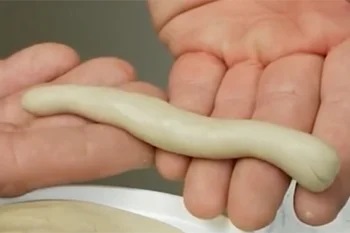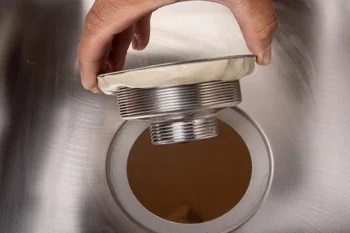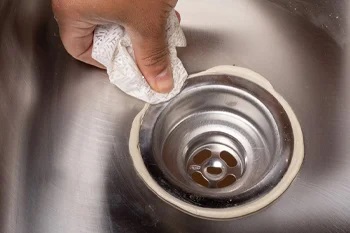By Sean Comerford
Plumber’s putty and silicone sealant are two common types of sealants used by plumbing professionals. But which one does what? And when should each be applied?
This article provides a detailed breakdown of the key differences between these two popular products and when to use them.
What is plumber’s putty?
Plumber’s putty is a sealing staple for professional plumbers. This easy-to-use product will prevent the migration of water between two rigid surfaces, keeping your fixtures leak-free. A malleable, clay-like compound, plumber’s putty creates a watertight seal by filling in the space under a flange to prevent water from seeping through.

What is silicone sealant?
You’ve probably noticed the terms ‘caulk’ and ‘sealant’ are often used interchangeably. The two products serve a similar purpose, which is to act as sealing agents to fill gaps and cracks, as well as bonding agents between building materials, such as joining countertops to sink bases. Intended to prevent leaks, they are both applied to surfaces using a caulking gun, which likely explains why a sealant is technically categorized as a type of caulk.
The key distinction between a caulk and sealant? Elasticity.
— Caulk is typically made from a mixture of latex and acrylic materials, which make it more rigid and prone to shrinking when cured.
— A sealant offers superior elasticity and water resistance, because it primarily contains silicone. The silicone material allows a sealant to easily expand and contract during changing temperatures without losing its airtight/watertight seal.
Therefore, sealants are a smart choice for areas that experience frequent weather fluctuation and high moisture levels, such as kitchens, bathrooms, as well as around doors and windows.
The two most important factors to keep in mind when selecting a caulk or sealant are the temperature range and moisture level at the site of application. Silicone sealant can be applied at temperatures between 0 to 120 degrees Fahrenheit and can withstand operating temperatures of -70° F to 400° F.
4 key differences between plumber’s putty and silicone sealant
1. Dry time: Plumber’s putty has no dry time, whereas silicone requires cure time. Typically, most siliconized sealants or caulks need approximately 24 hours to cure completely or a minimum of eight hours before exposing it to water or moisture.
After plumber’s putty has been applied and the fixture put in place, the latter can be used immediately. However, if putty is being used in colder applications, we suggest waiting 10 minutes after the initial installation to confirm the product does not need an extra turn to ensure it is properly secured.
Typically, most types of sealants need approximately 24 hours to cure completely or a minimum of eight hours before exposing it to water or moisture.

2. How it dries: Silicone sealant or siliconized caulk is an adhesive and cannot be remolded or replaced after it has dried. Plumber’s putty is an easily workable, soft, pliable, fixture-setting compound. Unlike some other sealants, plumber’s putty remains soft over time and can be easily modified after its first application.
Plumber’s putty will remain pliable when not exposed to air and can be used as a bedding compound for strainers, faucets, and tub waste and overflows once out of the container. However, if the putty is exposed to air for an extended period of time, it will harden and become brittle. Once the putty has dried, nothing can be added to regenerate the putty without affecting the quality of the product.
3. Clean-up: Plumber’s putty is also easier to clean than silicone, because it does not stick to hands and requires no additional tools. Applying silicone can get messy. As a result, many contractors carry additional products, such as a caulking gun or a silicone spray, to make the application easier. In contrast, when using plumber’s putty, you need no more than a tub of putty to get the job done.
4a. When and where to use it — Plumber’s Putty: Plumber’s putty is specifically designed for plumbing applications. It is ideal for setting faucets, sink basket strainers, shower and pop-up drains. It’s easy to wipe away after installation and will not be visible from the outside of the plumbing fixture once installed. Oatey Plumber’s Putty, for example, will last two years from the manufacture date if the lid is sealed properly.

Because plumber’s putty is oil-based, it can stain porous materials, such as granite, marble, quartz and sandstone. For application on these surfaces, use a stain-free plumber’s putty, as this product is oil-free and will not stain the porous material.
Plumber’s putty is shaped by hand before it is applied to the plumbing part. Prior to using plumber’s putty, ensure all surfaces are dry and free from hardened putty, dirt, wax, oil and grease. Remove debris by wiping with a cloth, scraper or wire brush as needed and dry the surface.
Read this blog for the steps to apply plumber’s putty.
Do NOT use plumber’s putty in these instances:
- On plastics (acrylic or ABS — Acrylonitrile Butadiene Styrene), because it will affect the integrity of the material and lead to product failure.
- In any pressurized connection, such as a gasketed fitting or on the thread of pipes. Although plumber’s putty creates a watertight seal, it is not an adhesive or glue.
- To seal a leaky toilet or toilet bowl to a finished floor, because plumber’s putty will dry out in the applications and is not waterproof. Cleaners and urine can also compromise the integrity of the putty if they come in contact with one another on the bathroom floor.
- To seal windows or doors, because plumber’s putty lacks any insulating qualities
- To install a drain on an acrylic tub and/or shower uni Stain-free and regular plumber’s putty can have an adverse effect on the finish of acrylic surfaces, similar to its effect on ABS plastic materials. You should use only 100%-silicone for this application.
4b. When and where to use it — Silicone Sealant: Due to a silicone sealant’s strong adhesiveness, elasticity and water-resistant properties, it’s an excellent choice for kitchen and bath applications, including:
- bonding top-mount and undermount sinks to countertops;
- bathtub/shower surrounds, doors and drains;
- sealing gaps and seams in gutters;
- filling exterior holes made by nails or screws;
- HVAC applications.
The bottom line
Plumber’s putty and silicone sealants are both great products to use on your projects, but they each have their own set of uses and benefits.
- If you’re looking for something that will withstand frequent weather fluctuation and high moisture levels, silicone sealant might be the best option.
- On the other hand, if you need something to prevent the migration of water between two rigid surfaces, keeping your fixtures leak-free, plumber’s putty is a smart choice.
 About the author: Sean Comerford is a Technical Applications Manager at Oatey Co. He is a third-generation tradesman with nearly 20 years of plumbing experience, including serving as the lead plumber for commercial/residential new-construction, service and fire protection jobs. He holds a State of Ohio Fire Protection License for Sprinkler and Standpipe.
About the author: Sean Comerford is a Technical Applications Manager at Oatey Co. He is a third-generation tradesman with nearly 20 years of plumbing experience, including serving as the lead plumber for commercial/residential new-construction, service and fire protection jobs. He holds a State of Ohio Fire Protection License for Sprinkler and Standpipe.




Join the conversation: